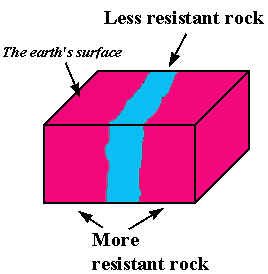

INSTRUCTIONS:
1. Print out this web page and bring it to lab.
2. Figure 5 is a geologic map of Manhattan, the Bronx, and adjacent New Jersey, showing sample locations. In the lab, examine rock samples 1 through 7. Locate their source on Figure 5. Then, complete the following table: (Sample 1 has been done for you as an example.)
| SAMPLE # | ROCK NAME | MAP COLOR (or GEOLOGIC "UNIT") |
| 1 | GNEISS | RED (FORDHAM FORMATION) |
| 2 | _ | _ |
| 3 | _ | _ |
| 4 | _ | _ |
| 5 | _ | _ |
| 6 | _ | _ |
| 7 | _ | _ |
In the Manhattan and the Bronx, bedrock lies at or near the surface of the earth. (Bedrock is the complex but continuous rock mass that forms the outermost crust of the earth and on which rest all the loose sediment, soil, water, vegetation, etc. (SEE PICTURES)) The bedrock in these two boroughs consists of three major rock types: samples 1, 2 and 3.
(A) Examine these samples visually. (B) Test them with acid and a nail.
Name the three rock types: (1)____________________(2)____________________(3)__________________
One of these three rock types is significantly less resistant to weathering and erosion than the other two.
Which rock type is the least resistant? ____________________
Why is it least resistant?__________________________________________________________________
| Imagine a place where bedrock with low resistance to weathering and erosion is surrounded by bedrock with high resistance. How would the elevation of the land surface overlying the low resistant bedrock compare with the elevation of the land surface overlying resistant bedrock? It would be __________________. What might you call the landscape feature underlain by the low resistant bedrock?____________________ |  |
TESTING YOUR HYPOTHESIS: To test your ideas about the effect of the resistance of bedrock on landscape, do the following:
1. Examine Figure 3, which shows the topography of Manhattan and the Bronx. Also examine Figure 5, which shows the geology of the same region.
2. On the geologic map, what color represents the less-resistant rock type in the boroughs under consideration? ____________________
3. On the topographic map, what color represents the lower areas? ____________________
4. In northern Manhattan and the western Bronx, is there a general correspondence between the low areas and the areas underlain by the less resistant rock type? __________
Does your answer to (4) support your hypothesis? __________